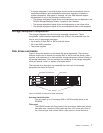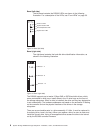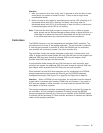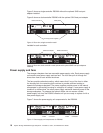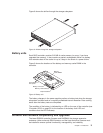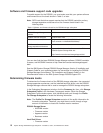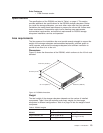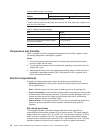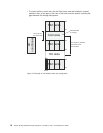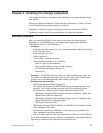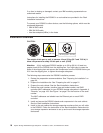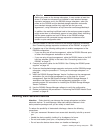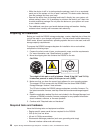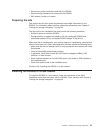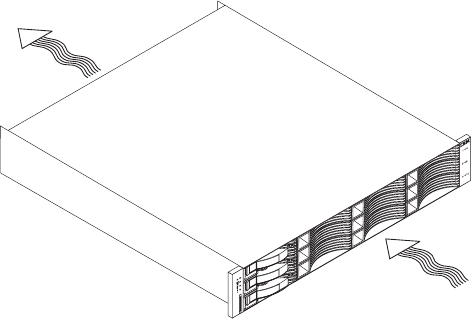
The agency ratings for the DS3200 storage subsystem are 6 amps at 100 V ac and
2.5 amps at 240 V ac. These are the overall maximum operating currents for this
system.
AC power recovery
After normal power is restored after a total ac power failure, the storage subsystem
performs power-on recovery procedures automatically without operator intervention.
Power cords and receptacles
The storage subsystem comes with two jumper cords that are used to connect to
the rack PDU. You must purchase the power cords that are applicable for use in a
typical receptacle in your country. See “Power cords” on page 106 for more
information.
Heat output, airflow, and cooling
Figure 11 shows the intended airflow for the DS3200. Allow at least 30 inches in
front of the storage subsystem and at least 24 inches behind the storage subsystem
for service clearance, proper ventilation, and heat dissipation.
When racks that contain many DS3200 storage subsystems are to be installed
together, the following requirements must be met to ensure that the DS3200
storage subsystems are adequately cooled:
v Air enters at the front of the rack and leaves at the back. To prevent the air that
is leaving the rack from entering the intake of another piece of equipment, you
must position the racks in alternate rows, back-to-back and front-to-front. This
arrangement is known as “cold aisle/hot aisle” and is shown in Figure 12 on page
16.
v Where racks are in rows, each rack must touch the rack that is next to it to
reduce the amount of hot air that can flow around from the back of the rack into
the intakes of the storage expansion enclosures that are in that rack. Use Suite
Attach Kits to completely seal any gaps that remain between the racks. For
details about Suite Attach Kits, contact your IBM marketing representative or
authorized reseller.
v Where racks are in rows front-to-front or back-to-back, gaps of at least 122 cm
(48 in.) must separate the rows across the cold aisle (see Figure 12 on page 16).
System Storage
Airflow
Airflow
Figure 11. DS3200 airflow
Chapter 1. Introduction 15



